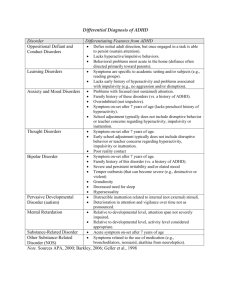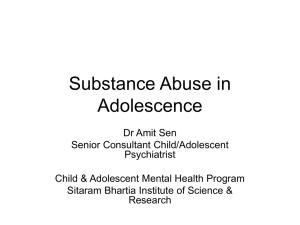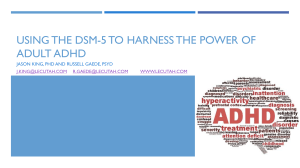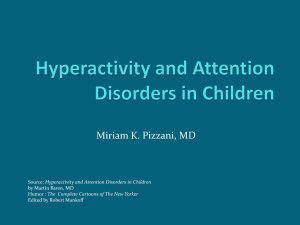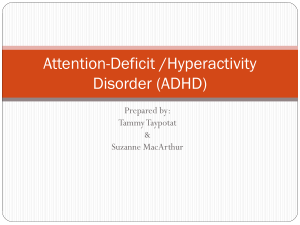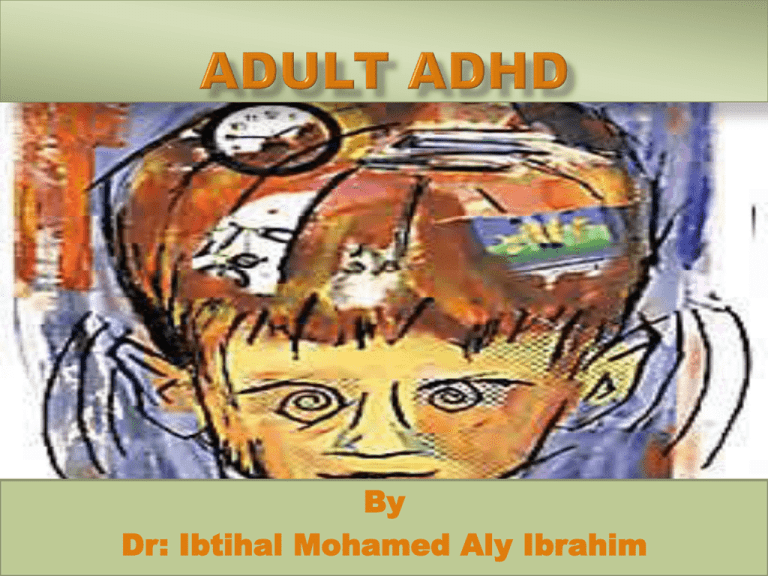
By
Dr: Ibtihal Mohamed Aly Ibrahim
Attention
deficit
hyperactivity
disorder (ADHD) has primarily been
considered a childhood condition.
Adults with the disorder were not
recognized until the 1970s when
diagnosis expanded to include ‘Adult
Hyperactives’
and later ‘Attention
Deficit Disorder leaving a residue’
difficulties
with impulse
control
difficulties
sustaining
Attention
Either (1) or (2):
(1) six (or more) of the following symptoms of inattention have persisted for at
least 6 months to a degree that is maladaptive and inconsistent with
developmental level:
A.
Inattention
(a)
(b)
(c)
(d)
(e)
(f)
(g)
(h)
(i)
often makes careless mistakes.
often has difficulty sustaining attention.
often does not listen.
often fails to follow through on instructions or to finish tasks.
often has difficulty organizing tasks and activities.
often avoids tasks requiring sustained attention.
often loses things.
often is easily distracted.
often is forgetful.
(2) six (or more) of the following symptoms of hyperactivityimpulsivity have persisted for at least 6 months to a degree that
is maladaptive and inconsistent with developmental level:
Hyperactivity
(a)
(b)
(c)
(d)
(e)
(f)
often fidgets or squirms
often leaves seat
often moves excessively (may feel restless)
often has difficulty playing or engaging in leisure activities quietly
is often "on the go"
often talks excessively
Impulsivity
(g) often blurts out answers
(h) often has difficulty awaiting turn
(i) often interrupts or intrudes on others
B. Some hyperactive-impulsive or inattention symptoms
that caused impairment were present before age 7
years.
C. Some impairment from the symptoms is present in
two or more settings.
D. There must be clear evidence of clinically significant
impairment in social, academic, or occupational
functioning.
E. The symptoms do not occur exclusively during the
course of a pervasive developmental disorder,
schizophrenia, or other psychotic disorder and are not
better accounted for by another mental disorder.
2) A
hyperactive
/impulsive
type
3) A
1) An
combined
inattentive
type
Coding note: for individuals (especially adolescents and adults
type
who currently have symptoms that no longer meet full criteria
“in partial remission” should be specified
The DSMIV, defines
three types
of ADHD
children
continue to
manifest
symptoms
in
adulthood
ADHD
ADHD
50% of
ADHD
Few
Studies
suggest
that
ADHD
may arise
de novo in
adulthood
50% of ADHD children continue to
manifest symptoms in adulthood.
Estimates of the prevalence of ADHD in
adulthood range from 1% to 5%.
adults with ADHD are twice as likely to
be arrested, have a two-fold increased
risk of being divorced, and a 78%
greater risk of being unemployed.
Disorganization
and forgetfulness
Impulsivity
Hyperactivity or
restlessness
Emotional
difficulties
poor organizational skills (home, office, desk, or
car is extremely messy and cluttered).
tendency to procrastinate.
trouble starting and finishing projects.
chronic lateness .
frequently forgetting appointments,
commitments, and deadlines.
constantly losing or misplacing things (keys,
wallet, phone, documents, bills).
underestimating the time it will take you to
complete tasks .
frequently interrupt others or talk over them
have poor self-control
blurt out thoughts that are rude or
inappropriate without thinking
have addictive tendencies
act recklessly or spontaneously without
regard for consequences
have trouble behaving in socially appropriate
ways (such as sitting still during a long
meeting) .
sense of underachievement
doesn’t deal well with frustration
easily flustered and stressed out
irritability or mood swings
trouble staying motivated
hypersensitivity to criticism
short, often explosive, temper
low self-esteem and sense of insecurity
feelings of inner restlessness, agitation
tendency to take risks
getting bored easily
racing thoughts
trouble sitting still; constant fidgeting
craving for excitement
talking excessively
doing a million things at once
Inattentive-type (ADHD-I)
Hyperactive/Impulsive-type (ADHD-H)
•Procrastination.
•Chooses highly active, stimulating jobs.
•Indecision, difficulty recalling and
•Avoids situations with low physical
organizing details required for a task.
activity or sedentary work.
•Poor time management, losing track of time.
•May choose to work long hours or two
•Avoiding tasks or jobs that require
jobs .
sustained attention.
•Seeks constant activity.
•Difficulty initiating tasks.
•Easily bored.
•Difficulty completing and following
•Impatient .
through on tasks.
•Intolerant to frustration, easily irritated.
•Difficulty multitasking.
•Impulsive, snap decisions and
•Difficulty shifting attention from one
irresponsible behaviors .
task to another.
•Loses temper easily, angers quickly.
eating disorders
bipolar
disorder
ADHD
depressive
episodes
substance use
disorders
Overlapping symptoms in ADHD and bipolar disorder.
ADHD
Bipolar disorder
1.
2.
1.
2.
More talkative than usual.
Distractibility or constant changes in
activity or plans.
3.
Increased activity or physical
restlessness.
4.
Loss of normal social inhibitions
Talks excessively .
Easily distracted/jumps from one
activity to the next.
3. Difficulty sustaining attention
4. Fails to give close attention to
details/makes careless mistakes.
5. Fidgets
6. Difficulty remaining seated
restlessness
7. Runs or climbs about
inappropriately
8. Difficulty engaging in leisure
activities quietly
9. On the go as if driven by a motor
10. Interrupts or butts in uninvited.
11. Blurts out answers before questions
have been completed
12. Difficulty awaiting turns
1- Comorbidity is a chance phenomenon.
2- Comorbidity is an artifact of overlapping
criteria.
3- Comorbidity is due to a common diathesis
that leaves patients vulnerable to separate
illnesses.
4- Symptoms of ADHD that precede the onset of
BD represent a prepubertal expression of
illness antecedent to the development of a
full affective episode.
"Protobipolar?"
A.
Retrospective childhood diagnosis:
Narrow criterion: met DSM-IV criteria in childhood by parent
B.
Broad criterion: both (1) and (2) are met as reported by the patient:
1.
1)
2)
2.
A.
B.
C.
D.
E.
F.
G.
3.
interview.
Childhood hyperactivity.
Childhood attention deficits.
Adult characteristics: five additional symptoms, including
ongoing difficulties with inattentiveness and hyperactivity and at least
three other symptoms:
Inattentiveness.
Hyperactivity.
Mood liability.
Irritability and hot temper.
Impaired stress tolerance.
Disorganization.
Impulsivity.
Exclusions: not diagnosed in presence of severe
depression, psychosis, or severe personality disorder.
Despite the relatively high prevalence of adult ADHD,
only 11% of adult patients are treated due to multiple
factors:
Failure to seek
medical advice.
Treatment of
the comorbid
condition
instead of
ADHD
Misdiagnosis
• first-line therapy.
• increases in blood
pressure
• block the uptake of
dopamine and
norepinephrine.
• better side-effect
• inhibiting the
norepinephrine
transporter.
• liver damage and
increased suicidal
ideation.
methylphenidate
Amphetamines
Atomoxetin
• lower treatment
effect than
stimulant
Antidepressants
Tips for managing stress and
boosting mood
Tips for getting organized and
controlling clutter
Develop
structure
and
neat
habits—and keep them up
Tips for managing your time and
staying on schedule
Tips for staying focused and
productive at work
Other types of Psychotherapy
Marriage and family
therapy
Cognitive-behavioral
therapy
Support groups for
adult ADD / ADHD
Option 1. No change, i.e., use existing
criteria, with no age-specific criteria.
Option 2. Lower threshold for
combined ADHD from 6 to 3 endorsed
criteria from each element (HI or I).
Physical and
mental health
problems.
Work and
financial
difficulties.
Relationship
problems.
• compulsive
eating.
• substance abuse.
• anxiety.
• chronic stress
• and tension.
• and low selfesteem.
• trouble keeping
a job.
• following
corporate rules.
• meeting
deadlines.
• struggle with
unpaid bills, lost
paperwork, late
fees, or debt.
• fed up with
constant
nagging from
loved ones to
tidy up, listen
more closely,
or get
organized


